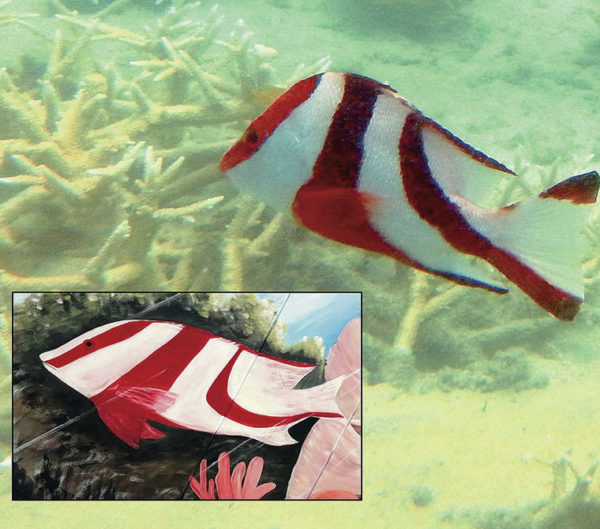Published in the Ocean Watch column, Honolulu Star-Advertiser © Susan Scott
December 21, 2019
The day after my first snorkeling trip in the Caribbean in 1981, I bought a pocket guide to Caribbean fish because I wanted to know the names of the fish I saw. Today, I know a lot more names now than I did then (none), but that makes spotting an unknown even more fun. Sometimes, a mystery species becomes a quest.
That happened last fall while snorkeling off Australia’s Palm Islands, an area teaming with life even for the Great Barrier Reef. I saw a striking fish I’ve never seen before. Given that the GBR hosts 1,625 fish species, a new one isn’t unusual for me. But even with a good photo of the red-and-white-striped beauty, I couldn’t find it in my numerous guides.
 Susan Scott’s red emperor, top, off Orpheus Island.
Susan Scott’s red emperor, top, off Orpheus Island.
Bottom, the red emperor painting in Reef HQ, the Great Barrier Reef Aquarium.
©2019 Susan Scott
Day after day, I poured through the books, but never did I find the striking fish with the sloped forehead. Had I found a rare species?
Hardly. Two weeks later, with Honu back in the Townsville marina, I walked to the Great Barrier Reef Aquarium (called Reef HQ) for help. But before I even got to the ticket office, there in the entrance hall, painted on the wall in a coral reef mural, was my fish.
“It’s a red emperor,” an aquarium worker said. “A common food fish here.”
That didn’t solve the puzzle though, because the red emperor of my books didn’t look like the red emperor of my photos or in the mural.
Here at home, where I have more books and the internet, I learned that I had found a juvenile red emperor. As sometimes happens, the immature form is quite different in color and shape from the adult form. Adults lose the stripes; the angled heads get rounded and the bodies become red all over.
Emperor fish are tropical reef inhabitants, hanging out near, or just outside, coral reefs. In addition to the red one, several family members are considered good eating throughout the world.
Australia hosts 19 emperor species. Hawaii has only one, called the bigeye emperor, or mu. The silvery gray mu usually hangs motionless, often alone, above sea floor rubble, using its large eyes to search for shelled prey.
Like its Australian red cousin, Hawaii’s juvenile bigeye emperors look different from their mature form, the young being black-and-white-striped with pointed snouts. Adults grow to 24 inches long. Hawaii’s weight record is 13 pounds.
The bigeye is a pipsqueak, though, compared to the red emperor, which grows to 45 inches long and weighs up to 72 pounds.
The pretty red-and-white-striped juveniles, like the one I saw, are popular in the aquarium trade, but be warned. When that cutie grows up, you’re going to need a bigger tank.
When in 1981, I bought that fish guide, I had no idea the little paperback would lead me, decades later, to whooping for joy over a mural in the Aquarium of the Great Barrier Reef. But that’s the beauty of books. And of fish.